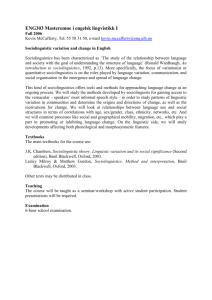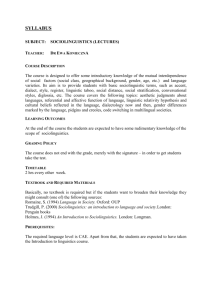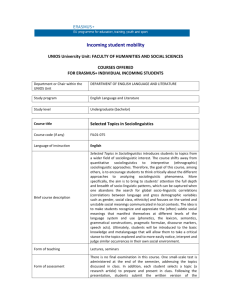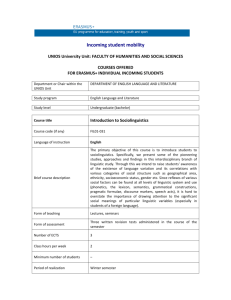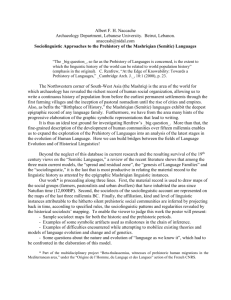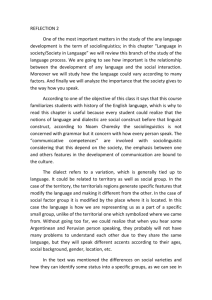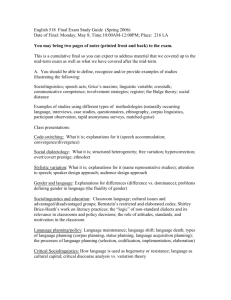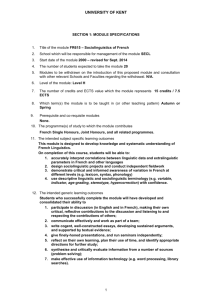LC-09 Diversity-02 - Michigan State University
advertisement
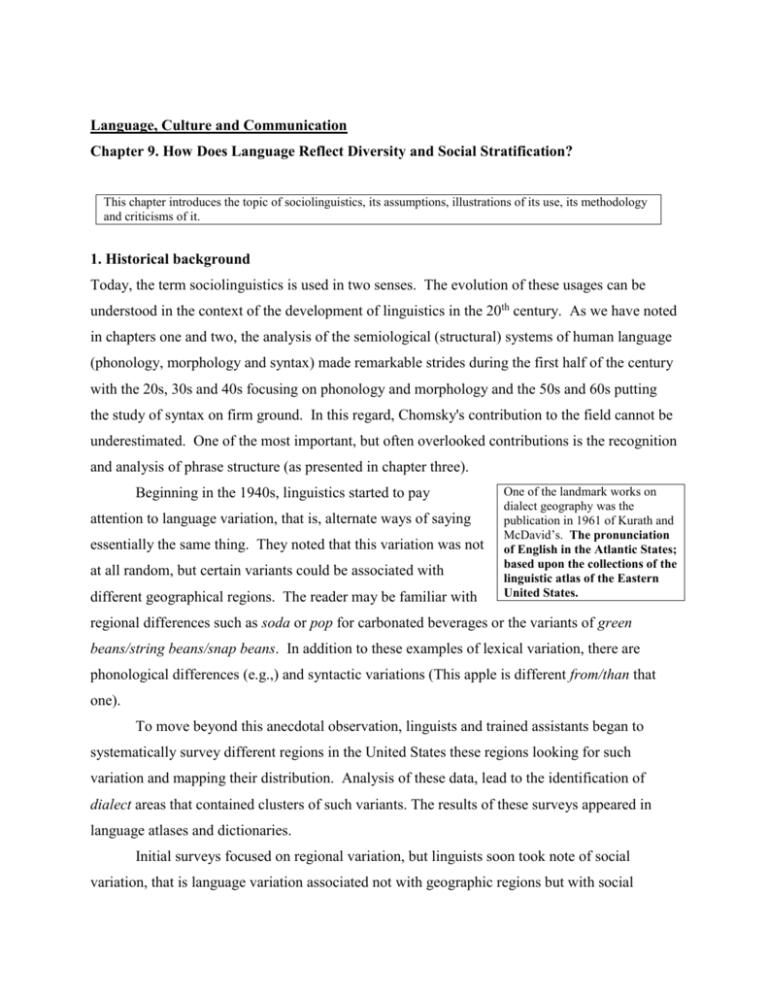
Language, Culture and Communication Chapter 9. How Does Language Reflect Diversity and Social Stratification? This chapter introduces the topic of sociolinguistics, its assumptions, illustrations of its use, its methodology and criticisms of it. 1. Historical background Today, the term sociolinguistics is used in two senses. The evolution of these usages can be understood in the context of the development of linguistics in the 20th century. As we have noted in chapters one and two, the analysis of the semiological (structural) systems of human language (phonology, morphology and syntax) made remarkable strides during the first half of the century with the 20s, 30s and 40s focusing on phonology and morphology and the 50s and 60s putting the study of syntax on firm ground. In this regard, Chomsky's contribution to the field cannot be underestimated. One of the most important, but often overlooked contributions is the recognition and analysis of phrase structure (as presented in chapter three). Beginning in the 1940s, linguistics started to pay attention to language variation, that is, alternate ways of saying essentially the same thing. They noted that this variation was not at all random, but certain variants could be associated with different geographical regions. The reader may be familiar with One of the landmark works on dialect geography was the publication in 1961 of Kurath and McDavid’s. The pronunciation of English in the Atlantic States; based upon the collections of the linguistic atlas of the Eastern United States. regional differences such as soda or pop for carbonated beverages or the variants of green beans/string beans/snap beans. In addition to these examples of lexical variation, there are phonological differences (e.g.,) and syntactic variations (This apple is different from/than that one). To move beyond this anecdotal observation, linguists and trained assistants began to systematically survey different regions in the United States these regions looking for such variation and mapping their distribution. Analysis of these data, lead to the identification of dialect areas that contained clusters of such variants. The results of these surveys appeared in language atlases and dictionaries. Initial surveys focused on regional variation, but linguists soon took note of social variation, that is language variation associated not with geographic regions but with social The Consequences of Language: Language Reflect Diversity and Social Stratification Chapter 9, Page 2 factors such as social class, ethnicity, gender, and social context. The study of this kind of social variation came to be known as sociolinguistics, while the study of regional variation was termed dialectology. Today, linguists tend to avoid the terms dialect and hence dialectology, because of the negative connotations associated with the term dialect (see chapter 12). The development of the field of sociolinguistics, which we shall explore below, marked a departure from the narrow focus by linguists on the structural (semiotic) properties of language to one that included a social dimension. The absence of interest in social matters is clearly stated by the most outstanding linguist of the 20th century, Noam Chomsky. Linguistic theory is concerned primarily with an ideal speaker-listener, in a completely homogeneous speech-community, who knows its language perfectly and is unaffected by such grammatically irrelevant conditions as memory limitations, distractions, shifts of attention and interest, and errors (random or characteristic in applying his knowledge of the language in actual performance. Chomsky, Aspects of a theory of syntax 1965:3 The important point that Chomsky makes here is that traditional linguistics does not consider linguistic variation to be an important aspect of the field of linguistics. Chomsky adds that “This seems to be to have been the position of the founders of modern general linguistics, and no cogent reason for modifying it has been offered” (ibid 3-4). Note that Chomsky’s position is virtually identical to that of Saussure’s who posited that a common collective langue was shared by members of the speech community.1 Needless to say that today this position has been strongly criticized, not only by sociolinguists, who study linguistic variation in the speech community, but by those who study language and power (Fairclough, Ricoeur and Foucault) who note that the presumption of an ideal, invariant language legitimizes the concept of a superior form of the language (e.g., “correct English” and inadequate forms often called “dialects.” This criticism is important indeed for all linguists recognize that the concept of good and bad forms of any language is simply wrong. We shall return to this issue in chapter twelve. Because of the denial of social investigation by traditional linguists, the term sociolinguistics was often used to refer to other dimensions of language and social interactions. In this broader usage, the study of the Whorfian hypothesis would be included. To avoid 1 Chomsky and Saussure did differ on a number of points including the social (Saussure) as opposed to the Psychological basis for language (Chomsky) and the use of signs (Saussure) as opposed to the use of rules (Chomsky) to represent the semiological systems of language. The Consequences of Language: Language Reflect Diversity and Social Stratification Chapter 9, Page 3 confusion2 in this book, we use the term sociolinguistics to refer to the study of language variation, and the term language 2. Sociolinguistic Variables To explain the basis for sociolinguistic analysis, Wald and Shopin (19xx) begin with the concept of the linguistic norm, which is they define as any linguistic feature that occurs regularly in the speech of more than one speaker in the community be it. phonological, lexical (morphological), syntactic or orthographic (spelling). When we think of language structure, we tend to think of the linguistic norm as opposed to the linguistic variable, which is defined as a linguistic unit realized, by more than one norm. In this sense the two pronunciations of the word economic (one pronounced with the same vowel as bee, and the other pronounced with the same vowel as bet) exemplifies linguistic variable. In Saussurian terms, this amounts to a single signified having two signifiers. When they are used in a sentence, there referential value (meaning) is the same. Wald and Shopen go on to define a special kind of linguistic variable, known as a sociolinguistic variable as a 1. He is going to the store. 2. He is goin to the store. linguistic variable sensitive to social context. They then illustrate the sociolinguistic variable with the opposition between going and goin. In comparing the two sentences in the sidebar, we see that referential meaning of these two sentences is the same, though we recognize the second sentence as more casual than the first. Sociolinguistics is the study of linguistic variables which primarily involves the investigation of social contexts. These social contexts are closely tied to the concept of the institution introduced in chapter two in two ways. First, some social contexts are the social institution itself and thus the sociolinguistic variable contexts is associated with the institution. When we listen to people speaking, we can often recognize the institution in which the speech is taking place, whether a place or worship, a classroom, a doctor’s office, a bar, a construction site, or an intimate relationship. We know this because we detect the sociolinguistic variables associated with the given institution. Second, within the institution are social roles: religious leader/worshiper; teacher/student; doctor/patient and the like. Sociolinguistic variables help us to identify and establish the roles that participants are playing within the institution. 2 One source of confusion in academic study is the failure to recognize that two concepts (signifieds) are represented by the same signifier, in this case the broad and narrow senses of sociolinguistics. The Consequences of Language: Language Reflect Diversity and Social Stratification The analysis of sociolinguistic variables would seem rather straightforward until we recognize that in a given conversation individuals may have the possibility of playing several roles at the same time. Suppose, for example, a professor meets a student of the Chapter 9, Page 4 Some Types of social context. Generational: Parents:Children Gender Men/Women Situational: Prestigeous/Casual Race/Ethnicity: Black/White/Hispanic/.. Class: White/Blue Collar Status: High/Low Friendship: Friends opposite sex who is the wife of a colleague in a bar. Note that man and woman are roles defined by the institution of gender. Here, both individuals have to grapple with the task of negotiating an appropriate relationship and as a result, the usage of sociolinguistic variables may become quite complex. As a result, the correlating of sociolinguistic variables is a complicated project in need of a systematic methodology. 3. An example of a sociolinguistic variable. The popular characterization of the sociolinguistic variable -ing/-in is one of good versus bad or sloppy English. Linguists note that this is a prescriptive approach in that it prescribes the proper usage as opposed to their preferred approach which they call descriptive, which describes what people do do, as opposed to what they should do. Sociolinguists object to the prescriptive approach because it is more interested in justifying (or legitimizing) one linguistic variable over another than in finding out how and why it is used. For example, prescriptivists often characterize the in variant as the careless or lazy form and in so doing they suggest that it is easier to say in than ing. Part of their thinking seems to come from the fact that the -in variant can be described as “dropping the g.” But from a phonological point of view, there is no g in the -ing form. This is because the orthographic (spelling) representation is a digraph. A digraph is the use of two letters to represent a single sound. The sequence sh is another example of a digraph. The sequence ng is the orthographic digraph for the sound _, which is technically a velar nasal. The sound n is an alveolar nasal. Thus, there is no basis for prescriptivists to claim that the in variant is easier to pronounce. Note also that there is no in variant in words like thing, Beijing, Fielding, bilabong, or furlong. Rather, the linguistic variable is restricted to the suffix -ing. Finally, Wald and Shopen point out that: The longevity of the opposition between [-IN]G and [-I]N is a sign of their utility. (ING) has endured in spite of the impulse language users have to resolve variable conflict and tidy up their The Consequences of Language: Language Reflect Diversity and Social Stratification Chapter 9, Page 5 language, their need for a standard in the form of meaning of each linguistic unit to which all members of their community can refer. Such a standard makes communication possible, and it is the stuff of group identity..... Quite apart from the literal meaning of the utterance "He's working," it adds an extra social dimension to have both G and N available... Wald and Shopen (1985:540-1). From: Fischer, 1958 These arguments support the position of the sociolinguists who point out the need to observe when forms are used and related social events. One of the first such investigation was by John Use of -ing/-in Sch. Children Girls Only Boys Only Average Boy "Model" Boy -ing 63% 83% 46% 55% 8% -in 37% 17% 54% 45% 92% Fisher (1958) who studied the distribution of -in and -ing in school children. As is shown in the adjacent table, he found that the -ing form was used more than the -in form and furthermore that girls used it more than boys. He also found that those characterized as aggressive, as in the “model boy” were far more likely to use the -in form. Wald and Shopen (1985) Furthermore, Wald and Shopen (1985) found that there are variations in usage with respect to the institutions of gender, friendship Friend Family Other M-M 29 18 4 M-F 23 11 30 F-M 19 16 15 F-F 12 12 10 and family. These examples illustrate the existence of the sociolinguistic variable, the correlation of a linguistic variable with a social context and the fact that the social context may be quite complex. We return to the question of the meaning of the sociolinguistic variable, later on in the chapter. 4. Gathering Data 4.1 What can be a sociolinguistic variable? Just about anything, a phonetic difference (-ing v. -in) a word choice (chairman v. chairperson; swearing v. not swearing), a syntactic choice (this is different (from v. than) that one), a speech genre (prestige v. casual usage) can serve as a sociolinguistic variable as long as there is a recognized choice between two forms. Generes are styles of speech that have an identifiable form, as does poetry as opposed to prose, that tend to be associated with specific social usages. The Consequences of Language: Language Reflect Diversity and Social Stratification 4.2 The Speech Community. Researchers usually begin with the concept of a speech community, even though there is no clear consensus as to what it is. 4.3 Language Use. As in the case of analyzing language structure, sociolinguists use a descriptive Chapter 9, Page 6 In analyzing linguistic phenomena within a socially defined universe, however, the study is of language usage as it reflects more general behavioral norms. This Universe is the Speech Community: any human aggregate characterized by regular and frequent interactions by means of a shared body of verbal signs and set off from similar aggregates by significant differences in language usage. Gumperz 1968:381 A speech community is a real social unit within which speakers share a repertoire of "ways of speaking"; that is, they share a set of rules for using and interpreting speech in all the special settings, nuances, and cultural meanings unique to a particular community. Hickerson 1980:81 approach because they wand to finding out how language is used as opposed to a prescriptive approach which states how someone thinks language ought to be used. If fact, the prescriptive approach boils down to the defining of the linguistic variant that reflects elite or prestigious use and in so doing define other variants as less prestigious. 4.4 Types of data collection. One of the biggest problems with data collection is the observer’s paradox which notes that when the investigator draws the speaker’s attention to the variable, the speaker may become self-conscious of his or her own speech and adjust their speech so that the speaker’s responses do not reflect their normal usage. Because of this, investigators often disguise the focus of their research so that their subjects can perform more naturally. However, even the presence of a microphone or a researcher may unsettle the subject. Further complicating this kind of research, is the requirement that researchers receive permission from their subjects after fully informing them of the nature of the research and how it will and will not be used. It is also the case that given the situation, some methods will prove more suitable than others. Reading a list of words that contain the linguistic variable will not work if the subject is too young to read. Below are a few such techniques that sociolinguists have developed. The oral interview: The researcher and the subject interact in a conversation, with the researcher guides the conversation in ways that will produce the desired information. The word list: The subject reads a list of words prepared by the researcher. The essay: The subject writes an essay suggested by the researcher. Preference: The researcher plays for the subject (or gives in writing) a pair of words or sentences asking which sounds better. Self-Report: The researcher asks the subject which of two or more words or sentences he or she is likely to use. Identify Social Relationship: The researcher plays a tape of a conversation and asks the subject to identify the social relationships of the conversants. Textual Analysis. The researcher examines existing texts for instances of the usage of the variable. The Consequences of Language: Language Reflect Diversity and Social Stratification Chapter 9, Page 7 5. Other Examples 5.1 Martha’s Vineyard. The speech of the people who live on Martha’s Vineyard, a sizable island off the southern coast of Massachusetts, is marked by a phonetic linguistic variable, the centralization of the diphthongs /ay/ and /aw/. To understand centralization, we begin with the notion of a diphthong, which consists of a vowel nucleus, followed by a glide such as /y/ or /w/. Technically speaking a glide is a vowel but not a syllabic unit. In saying a diphthong like /ay/ we hear a single syllable starting with the vowel /a/ (as in ha and ending with the sound /i/ as in ee. In most dialects of English, these diphthongs appear in the words high and how. Thus (there are some dialects of English, however, in which the glide has been replaced by a lengthening of the vowel, so that the word high is pronounced like ha with the vowel drawn out. Centralization refers to a change of vowel quality from /a/ (ah) to /_/ (uh) under certain conditions. In most dialects the vowel /_/ is the vowel found in words like but and love. ride write loud out knife non-centralized [rwayd] [rwayt] [lawd] [awt] [nayf] centralized [rwyd] [rwyt] [l wd] [wt] [nyf] Also, in most dialects of English, the diphthong /ay/ is centralized to /_y/ when followed by the sound /t/ and other voiceless consonants like /f/ (see chapter 3). However, the diphthong /aw/ is unaffected. In the adjacent table, the common English pronunciations are marked in bold. In Martha’s Vineyard, not only does /ay/ centralize before voiceless consonants like /t/, but /aw/ does so as well. While we have presented the opposition between /a/ and // as a discrete difference, it actually represents a continuum, and thus one can speak of a degree of centralization. In measuring the degree of centralization, Labov (1972) proposed a four-point scale ranging from 1 for [a] and 4 for [] with 2 and 3 representing points in between. Labov, then developed a procedure for determining the degree of centralization of a speaker which included the degree of centralization for the words containing the diphthongs /ay/ and /aw/ included in the degree of centralization. The Consequences of Language: Language Reflect Diversity and Social Stratification Labov interviewed 69 people or roughly 1% of people living on the island. This included 40 up islanders and 29 down islanders (see map). Interviewees were asked to read a sample text and/or a word list, and the data sampled included as 3500 words containing /ay/ and 1500 words containing Chapter 9, Page 8 Geography Down Island Edgartown Oak Bluffs Vineyard Haven ay 35 48 33 24 aw 33 55 10 33 Occupation Fishermen Farmers Others aw 100 32 41 ay 79 22 57 Up Island Oak Bluffs N. Tisbury Chilmark aw 61 71 35 100 ay 66 99 13 81 Gay Head 51 82 /aw/. A score (1-4) given to each word based on degree of centralization. Each subject given a score based on results of individual words. Higher scores = more centralization. Although the data so far has established that centralization is a linguistic variable, it has not yet established a linkage to a social factor. To determine this Labov looked at factors like geography, where he found a significant difference between up islanders, who were far more likely to centralize than down islanders (see map). With respect to occupation, Fishermen were far more likely to centralize than others including farmers, who centralized the least. He then turned to differences in centralization among the three major ethnic groups on the island, English, Portuguese and Native American. These too produced significant differences but of even more >60 46-60 31-45 <30 all English ay aw 36 34 85 63 108 109 35 31 67 60 Portuguese ay aw 26 26 37 59 73 83 34 52 42 54 Native ay aw 32 40 71 100 80 133 47 88 56 90 interest is the fact that there were huge differences in age. As can be seen in the table below, the 31-45 year old group centralized the most, with lesser amounts in both directions. These figures were far more significant than those of geography and occupation. After examining these data, Labov concluded that, in Martha’s Vineyard, centralization serves as a island identity marker, which not only shows one’s commitment to living on the island but helps to identify mainlanders and those who plan to leave the island. This helps to explain why centralization is not as pronounced in 90 80 70 60 50 40 30 20 10 0 aw ay 75 - 61-75 46-60 31-45 14-30 the youngest group, for this group consists of two populations, those who plan to stay and those The Consequences of Language: Language Reflect Diversity and Social Stratification Chapter 9, Page 9 who plan to leave the island and seek employment on the mainland. Were the “mainlandleaving” group and the “island-staying” group to be separated, we would see that the “islandstaying” group would have as high, if not higher a degree of centralization as do the 31-45 year olds. Note that citizens in the survey over the age of thirty have already made the decision to stay, while those deciding to leave have already left. The lower degree of centralization among the older citizens of the island reflects the likelihood that the development of the centralization of /ay/ and /aw/ is a sociolinguistic variable in progress, with younger citizens centralizing more than older ones. 5.2 Wolof Greetings. Judith Irvine (1974) reported on the greeting system of the Wolof, a pastoral/agricultural group living along the Senegal River in Senegal, West Africa. They have a clearly defined set of classes (or castes) consisting of Griots (praise singers), (former) Slaves, Freemen and Nobles. Greetings. In general, greetings in West Africa take place much more frequently than they do in the West. It is quite common for West Africans to re-greet someone after only a few hours absence. Furthermore, everyone, friends and strangers alike are expected to greet one another. Such greetings are usually longer and more elaborate than in the West. The Consequences of Language: Language Reflect Diversity and Social Stratification For example, Wolof Chapter 9, Page 10 Low Mohammed High Salisu Salaam alikum. (Arabic) Peace be with you. Malikum salaam. (Arabic) With you be peace. form. For example, one will Mohammed (Says his own name) Salisu (Says his own name.) always find the following Salisu Mohammed components in the Wolof Na ngga def? How do you do? Maanggi fi rek. I am here only. Mbaa dyamm ngg'am? Don't you have peace? Dyamm rek, naam. Peace only, yes. Ana waa kir gi? Where [i.e., how] are the people of your houshold? Nyu-ngga fa. They are there [ok]. Ana __________ (e.g. Mustapha)? Where [how] is ____ (Mustapha)? Mu-ngga fa. He's there [ok]. Mbaa tawaatu loo? Isn't it that you arn't sick. Maanggi sant Yalla. I am praising God. Mbaa keen feebarul? Isn't it than anyone isn't sick. Nyu-nggi sant Yalla. They are praising God. H'mdillay (Arabic)/Tukbarkalla. Thanks be to God. H'mdillay (Arabic)/ Tukbarkalla. Thanks be to God. greetings are highly formal, in the sense that the greetings have a clearly identifiable greeting: Salutation, Heath Question, Praise of God, body of conversation and Closure. In addition, every greeting has two distinct roles based on status: which we shall call high and low. Status is determined by a variety of factors: social class, wealth, age (unlike the West, increasing age is regarded by many African communities as an asset), social prestige, intellect and gender. Wolof have a proverb which says, “when two persons greet, one has shame, the other glory.” Associated with the role of low and high are several features of speaking that also help to identify Position Moves to Greet Stress Tempo Lower Social Rank Initiates Yes High, Loud Rapid, Verbose Higher Social Rank Responds No Low, Soft Slow, Terse these roles. The person of lower social rank initiates the greeting and moves to greet the person of higher social rank. This person also speaks rapidly with a high pitched, loud voice while the respondent does not move, speaks with a low, soft voice throughout the greeting. When the opportunity presents itself, the initiator will use more words while the respondent will use fewer words to convey the message. The choice of greeting roles (low and high) represents a social linguistic variable that serves to establish where one stands socially with others in the Wolof community and is a formal The Consequences of Language: Language Reflect Diversity and Social Stratification Chapter 9, Page 11 indication of an understanding of the relationship and an acceptance of one's general "duties of one's place in society" (Irvine 1974:xx). When two individuals meet, the relationship may be more that of establishing and affirming ones social status respect to the other. For example, if the two individuals are in the same family, there may be social obligations between the two such that high may be obliged to assist those of less status with material and other types of support. If low has need of this support, he/she may play the role of for all it is worth. If high is not inclined to provide this support, he/she may try to underplay the role. In some cases, the high may even try to initiate the greeting and use the features of low to suggest that he is not in a position of high and thus not obliged to assist. Irvine has noted that there are other ways that the two roles may be manipulated as well: Deference (politeness). "This interpretation is accorded to the Noble who has taken the role of initiator in greeting someone whose status is obviously not higher than his own." The use of s (low, soft), a noble style, indicates that he is still a noble even though he may use the rapid, verbose style of a lower-ranked person. Impudence. "Conversely, a griot taking the respondent role when greeting someone o higher rank than himself; his performance will be interpreted as rude or even threatening. The Griot is reminding his "partner" of his cast by using his cast features of a high-pitched, loud voice, but at the same time hinting at his power over him using the higher class slow, soft voice. If you do not give the Griot presents and become his patron, he will insult you and spread gossip about you all over town. Loss of control. For the noble to use a loud high-pitch voice or for the Griot to use a soft low-pitched voice, both contrary to their rank will indicate a loss of control. Sometimes, agreement does not occur: 1) Either an individual wants to be perceived as more noble, thus receiving greater honor and respect, or 2) the individual wants to be perceived as less noble, and with lesser obligations. In both cases, there will be an attempt to manipulate the greetings by either both rushing to greet or pausing to be a respondent. In these cases, the outcome indicates a dissatisfaction with the relationship. 6. Gender Variables (see chapter 11). 7. Issues concerning Sociolinguistic Variables 7.1 What does a sociolinguistic variable do? Recalling that the sociolinguistic variable has been defined as a linguistic variable associated with a social context, the task of sociolinguistics is to The Consequences of Language: Language Reflect Diversity and Social Stratification Chapter 9, Page 12 determine these associations. However, this characterization is not without problems. For example, most sociolinguistic variables are not exclusively associated with a single social context3. In the case of the -ing v. -in variable, we can not find a single social context in which ing or -in occurs exclusively and as the examples show, the variable is associated with several social contexts: gender, classroom, etc. This makes it impossible to state categorically where ing and -in will occur, a situation quite different from rules of language structure where rules apply whenever the conditions are met. This situation has lead Fairclough (1989) to point out that sociolinguistics is very good at pointing out the what (the association of linguistic variables with a cultural context) but not the why. Noam Chomsky: Again, a discipline is defined in terms of its object and its results. Sociology is the study of society. As to its results, it seems that there are few things one can say about that, at least at a fairly general level. One finds observations, intuitions, impressions, some valid generalizations perhaps. All very valuable, no doubt, but not at the level of explanatory principles. Literary criticism also has things to say, but it does not have explanatory principles. Of course ever since the ancient Greeks, people have been trying to find general principles on which to base literary criticism, but, while I'm far from an authority in this field, I'm under the impression that no one has yet succeeded in establishing such principles. Very much as in other human sciences. That is not a criticism. It is a characterization, which seems to me to be correct. Sociolinguistics is, I suppose, a discipline that seeks to apply principles of sociology to the study of language; but I suspect that it can draw little from sociology, and I wonder whether it is likely to contribute much to it. Mitsu Ronat: In general one links a social class to a set of linguistic forms in a manner that is almost bi-unique. Noam Chomsky: You can collect butterflies and make many observations. If you like butterflies, that’s fine; but such work must not be confounded with research, which is concerned to discover explanatory principles of some depth and fails if it does not do so. Language and Responsibility: Noam Chomsky based on conversations with Mitsou Ronat. 1977. Noam Chomsky (1977) said much the same thing, that, unlike modern structural linguistics, sociolinguistics as it is presently practiced, was devoid of explanatory principles. Admittedly, Chomsky is articulating an unappreciative positivist perspective; he is challenging the main tenet of sociolinguistics that of linking linguistic variables with social context as of limited value, until one addresses the question of why are there sociolinguistic variables? The very fact that linguistic variables are not entirely predictable provides a clue to understanding their use. In the case of the Wolof greeting, the significance of the first or second position in a greeting is that of establishing or affirming one’s social position with respect to that of the other. Here again, one can see a correlation between the variable and the social context, but the interesting part of Wolof greetings is that it is not fixed, that in some cases individuals may vie for one position or the other. From this perspective, the taking of one position or the 3 There are variables like “dearly beloved, we are...” or “here ye, hear ye, the court...” which are uniquely tied to a specific social context. These tend to be words or phrases as opposed to phonological or syntactic variables. The Consequences of Language: Language Reflect Diversity and Social Stratification Chapter 9, Page 13 other is sending a message about how the individual is to be perceived. Thus, the choice of one variable or the other is a statement of meaning, and clearly not a conditioned response or the mere carrying out of a linguistic rule. Sociolinguistic Variables as Semiological Signs. One way to understand the variable is to recast, in Saussurian terms as signs operating as small closed semiological systems which convey additional information about the user and the user’s relation to the other. From the perspective of the user, Bourdieu would consider the variable to be a institutional resource, although not without constraints. From this perspective, it is clear that centralization is clearly a statement that the user identifies him/herself with being an islander standing apart from mainlanders who do not centralize. We also see the variable -ing/-in operating with the -in identifying that the situation is more casual. We can also begin to see why the usage of this variable bears a gender asymmetry, if we find that women (and girls) prefer to negotiate in more formal social settings. Thus, individuals can use variables like these, not simply to convey information about something, but to negotiate the context in which they are to interact. This perspective helps to explain why linguistic variables do not simply disappear. While it is true that words which loose their relevance, often because their referent falls into disuse, and disappear, those which remain useful do not. Thus, one would conclude that the -ing v. -in variable continues to be useful for English speakers. 7.2 How do sociolinguistic variables arise? With the rise of sensitivity about gender inequality in the United States, a number of corrective measures were instituted like replacing ‘chairman, postman, stewardess’ with ‘chairperson, letter carrier and flight attendant. A number of eminent scholars criticized this development stating that changing the signifier would not end gender asymmetry. That no doubt is true, but what was missed in this was that a new sociolinguistic variable did arise. One now has the choice of saying ‘chairman’ or ‘chairperson’ and in so doing the choice of stating one’s sensitivity or insensitivity to gender issues. The very fact that there are people supporting each variable is an indication that the variable will persist. The answer to why and how variables arise is difficult to answer. From a semiological point of view, the sociolinguistic variable is a signifier part of a sign that is “arbitrarily” associated with a meaning. This means that virtually any signifier can serve to mark a social meaning. From this perspective, there is no reason why centralization of the diphthongs /ay/ and /aw/ The Consequences of Language: Language Reflect Diversity and Social Stratification Chapter 9, Page 14 needs to mark ‘identity to the island’ or that -in should identify a casual social setting. It does suggest however, the possibility that any linguistic variable can be pressed into service as a sociolinguistic sign. 7.3 The issue of Power. Another criticism of sociolinguistics is its failure to deal with power and privilege, for it merely states the social distribution of linguistic variables. In this sense, it does not address the question of access to use of such variables. The lack of mastery of a variable like ‘prestige English’ represents an issue of privilege, or the refusal to use it, a question of power. In other cases, one may not have the right to use a given form. The question of power is addressed in chapter 10, from a different perspective Summary Questions for Study and Review In Mackinaw City, famous for its fudge, year round citizens refer to tourists as “fudgies” because of their extravagant fudge buying tendencies. Using the notion of a sociolinguistic variable as a statement of meaning state how the term fudgie is used. Suggested Readings Kurath, Hans. Linguistic atlas of New England, by Hans Kurath, director and editor [with the collaboration of] Miles L. Hanley, associate director; Bernard Bloch, assistant editor, Guy S. Lowman, jr., principal field investigator, Marcus L. Hansen, historian...sponsored by the American council of learned societies and assisted by universities and colleges in New England. Providence, R. I., Brown University, 1939-43. Kurath, Hans. The pronunciation of English in the Atlantic States; based upon the collections of the linguistic atlas of the Eastern United States. By Hans Kurath [and] Raven I. McDavid, Jr. Ann Arbor, University of Michig Press. 1961. Cassidy, Frederic Gomes. Dictionary of Jamaican English; edited by F. G. Cassidy and R. B. Le Page. London, Cambridge U.P., 1967
